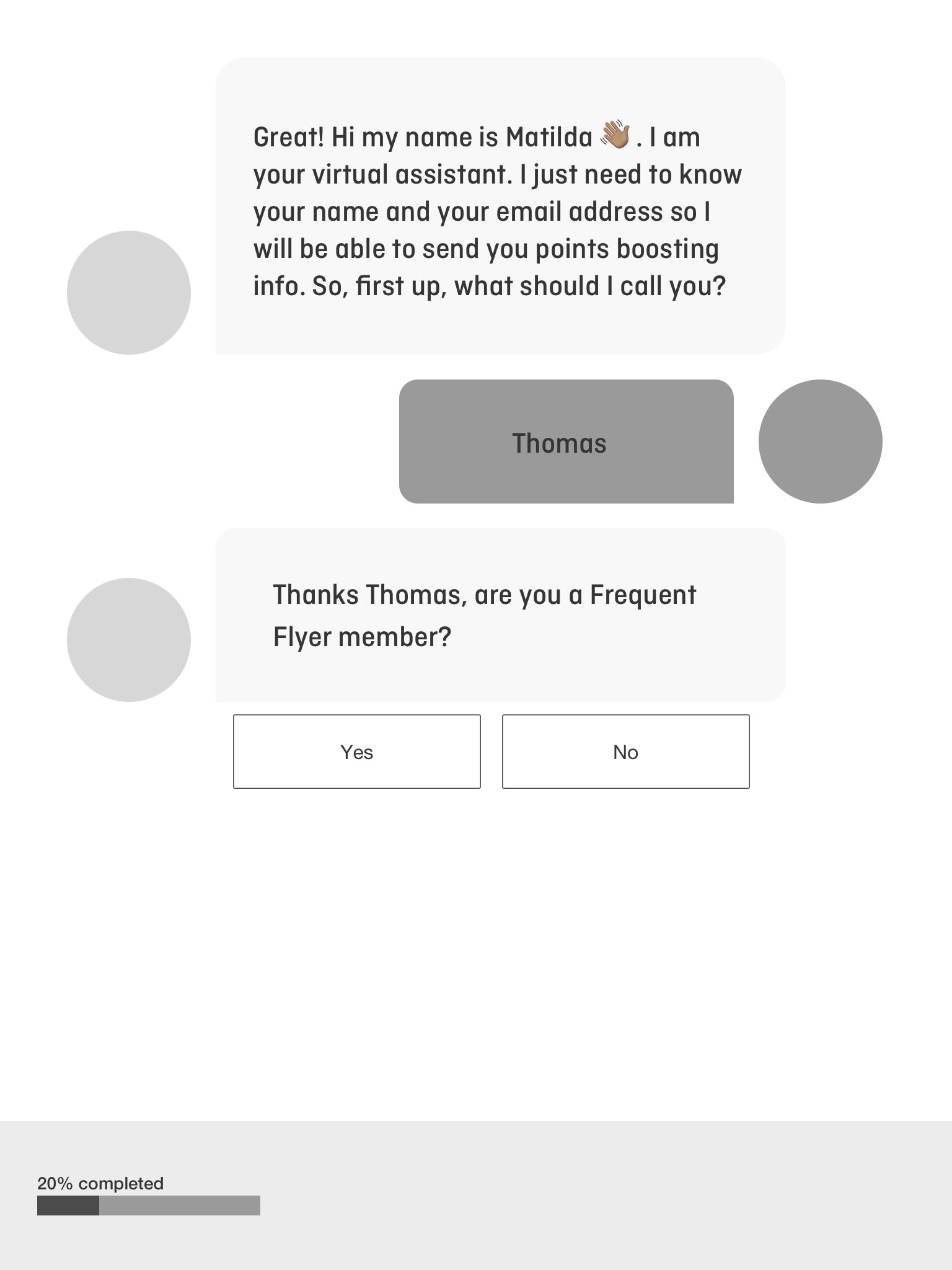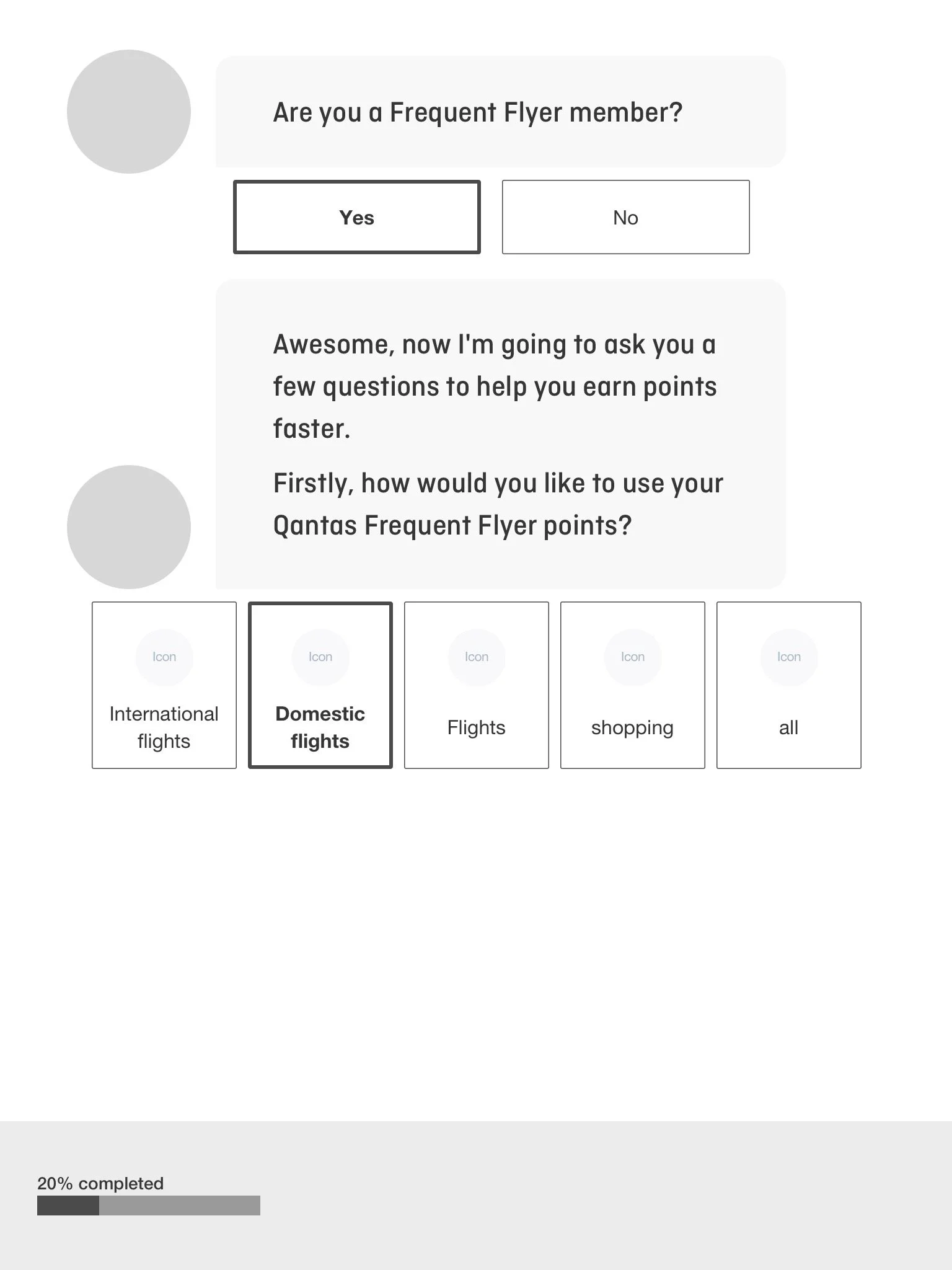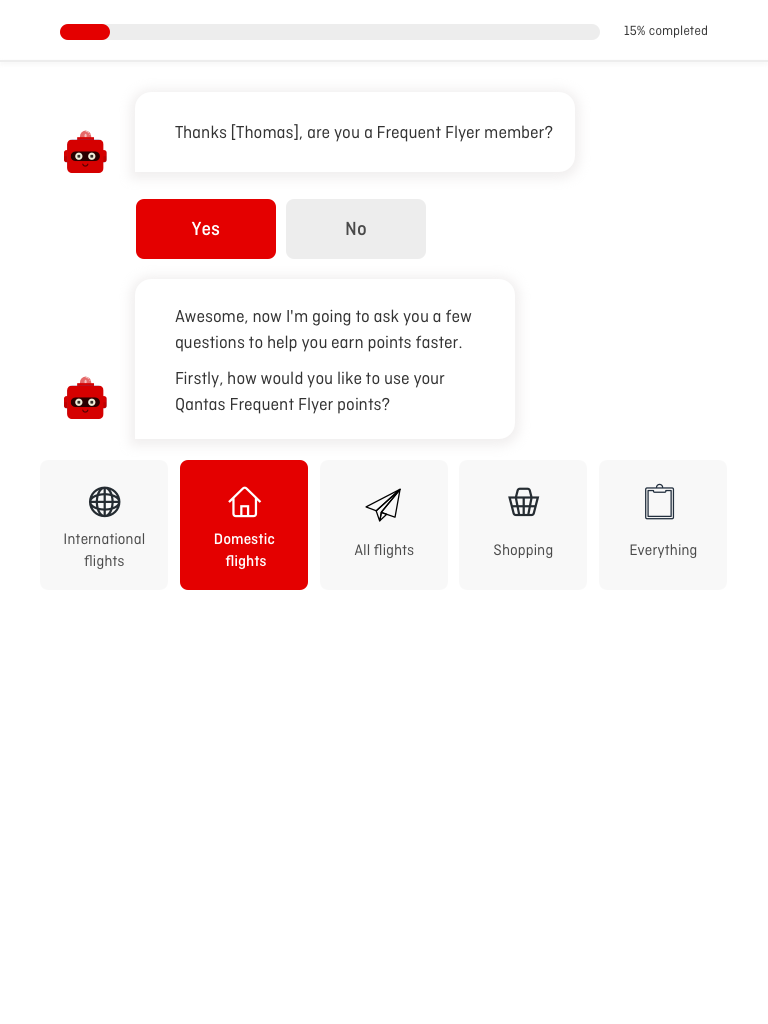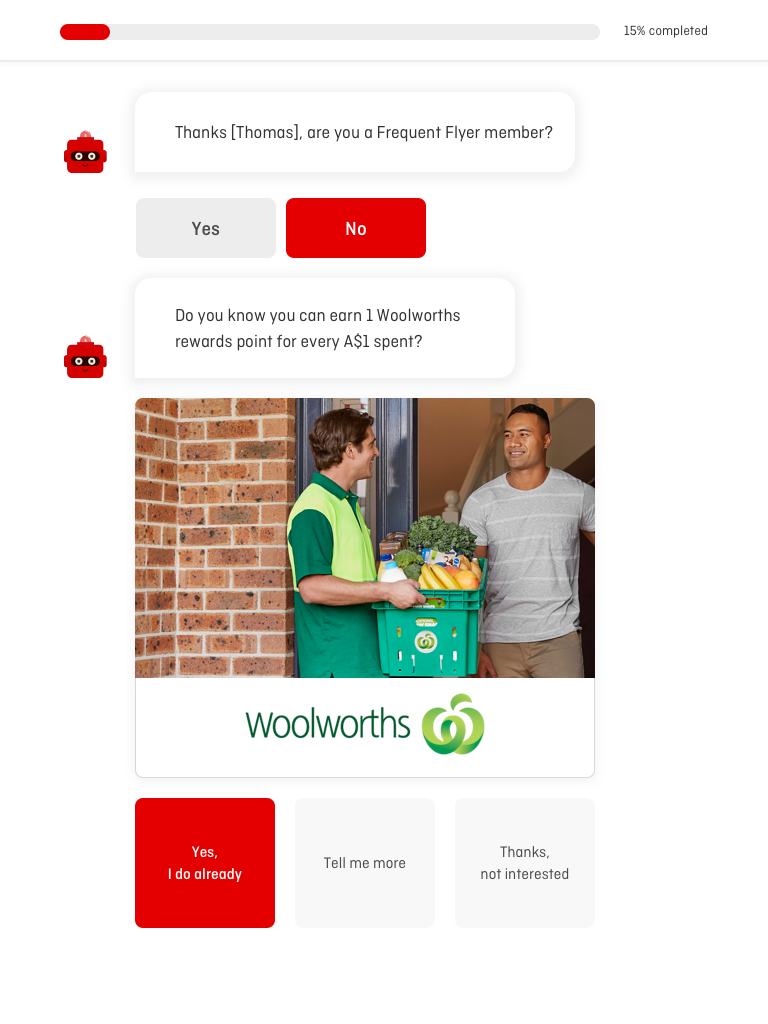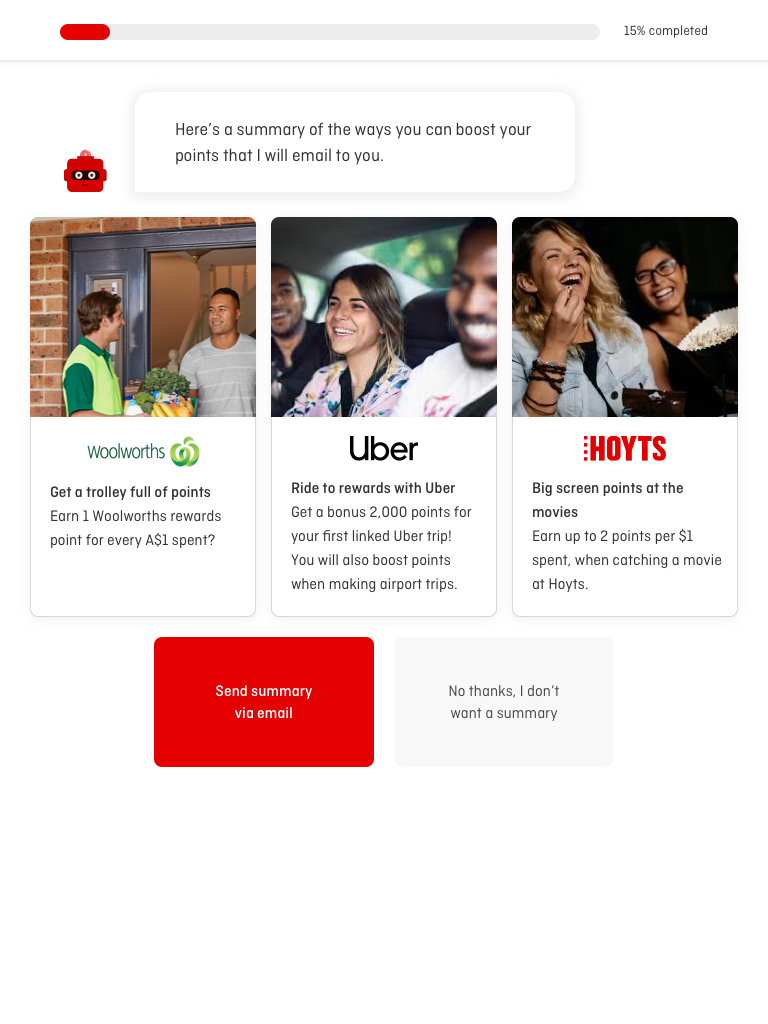Let’s talk: Qantas virtual assistant.
Client. Qantas Loyalty Program.
Understanding the Issue.
To understand the loyalty program's benefits, Qantas Frequent Flyer customers must phone the call centre and complete a questionnaire on the Qantas business partners. The exhaustive questionnaire touched on topics including lifestyle, products, and purchase frequency. The questionnaire could take up to 30 minutes in total to complete. The problem to solve was how to reimagine this experience.
Considerations.
Customers could request a tailored email with the Qantas business partner offers, the number of points they could earn and links to the offers.
The technical development team explored whether a virtual assistant experience could be viable. The solution of a chatbot experience still needed to be validated with customers.
There were no existing assets for the virtual assistant experience, except for the call centre scripts. The call centre scripts had to be evaluated to determine if they could be directly utilised in a virtual assistant experience.
Qantas had yet to build a virtual assistant. This product would be a first.
A separate product team was researching the avatar's characteristics, look and feel.
Discovery.
The delivery framework timings were agreed upon before starting this engagement; therefore, the first step was to understand the problem statement and familiarise myself with the project's progress, including any UX decisions the team had made. I initiated this process by conducting a workshop with the stakeholders.
The session served as a 'questions and assumptions' exercise on the product. We learned that considerable effort, budget, and stakeholder engagement activities had already been invested in a tablet device chatbot experience. This was our starting point.
Analysis.
We reviewed:
Approaches and decisions for the call centre questionnaire to find out if these could be applied to a simplified tablet chatbot experience
Call logs, which revealed customer pain points and goals
Call scripts – there were 31 questions across five categories: Home Express, Lifestyle and Entertainment, Travel, Financial and Reward.
Challenges included.
Time constraints and customer privacy concerns included where to place the tablets in the Qantas shop at the airport.
Existing questions were lengthy and inappropriate for a chatbot interface.
Define.
We wanted to create a streamlined and frictionless customer experience.
It was, therefore, critical that a chatbot would have a natural flow of language, interaction, and timing to be effective, user-friendly and, ultimately, successful.
Given the tight launch schedule, stakeholders decided to predefine responses to the questions. So, rather than developing a chatbot with AI capabilities, we pivoted to a virtual assistant that would guide customers in a linear way while mimicking person-to-person conversations.
Exploration.
We applied a conversational tone and appropriate communication style to ensure questions were friendly, informative and resonated with customers.
To ideate on the right problems, we constructed how-might-we questions. The outcome was fewer questions and more concise, targeted language for the script.
Two ideation sessions and guerrilla testing with customers validated our approach. The multiple-answer questions incorporated logic based on user responses. However, 15 questions still seemed excessive.
We tested a simplified version of the chatbot experience on a tablet. Based on the feedback, we refined the script for the interactive prototypes.Prototypes
Prototypes.
We started with basic wireframe sketches and interactive prototypes. Customer feedback on these low-fidelity prototypes informed two high-fidelity versions.
To gather feedback, the team set up two high-fidelity prototypes on tablets for usability testing 'in the real world' - i.e., in the Qantas shop at Sydney Domestic Airport.
Test and learn.
This experiment was exciting as it was the first time Qantas had attempted it. Customers said they would approach the tablet without encouragement. This was mainly due to the conversational welcome message. Tick!
Customers found the virtual assistant incredibly helpful, discovering new ways to boost points effortlessly. Tick!
Business opportunities.
We identified further business opportunities in the rewards program space during the project's development stage. Specifically improving the onboarding process for new and dormant customers and addressing pain points and critical moments.
Deliver.
A virtual assistant – or chatbot with predefined responses – that received excellent customer feedback.
The result.
Virtual assistant components were integrated into the Qantas Design Language System.
A cultural shift towards a human-centred design approach across Qantas' digital teams
Increased collaboration among previously isolated virtual assistant teams and projects.
UX learnings adopted by other teams working on virtual assistant experiences.
A deeper understanding of AI experiences.
Major achievements.
• Successful launch of the virtual assistant
• Excellent customer feedback
Example of the first interactive screen of the Qantas Frequent Flyers virtual assistant. During the wireframe phase the virtual assistant’s working title was ‘Matilda’. The completion metre during this phase was at the bottom of the tablet. Due to technical issues and customer feedback, the component was placed at the top of the device.
This wireframe example asks the customer if they are a Frequent Flyer member and how they would like to use their Qantas Frequent Flyer points. Based on the answer, logic is built in to display relevant follow-up questions.
Wireframe example for customers who aren't Frequent Flyer members, we pose a question from a Qantas business partner to introduce them to the brand and provide information on how they can earn points.
Example of the initial visual design for an interactive prototype. At this stage, we were still exploring the look and feel of the avatar.
This example of the visual design shows the fonts and iconography to be used on the virtual assistant.
Visual design example for customers who aren't Frequent Flyer members, we pose a question from a Qantas business partner to introduce them to the brand and provide information on how they can earn points.
Visual design example of the summary presented to customers. Customers have the option of having a summary emailed to them or not.
The final design of the avatar for Qantas virtual assistant, Skye.



